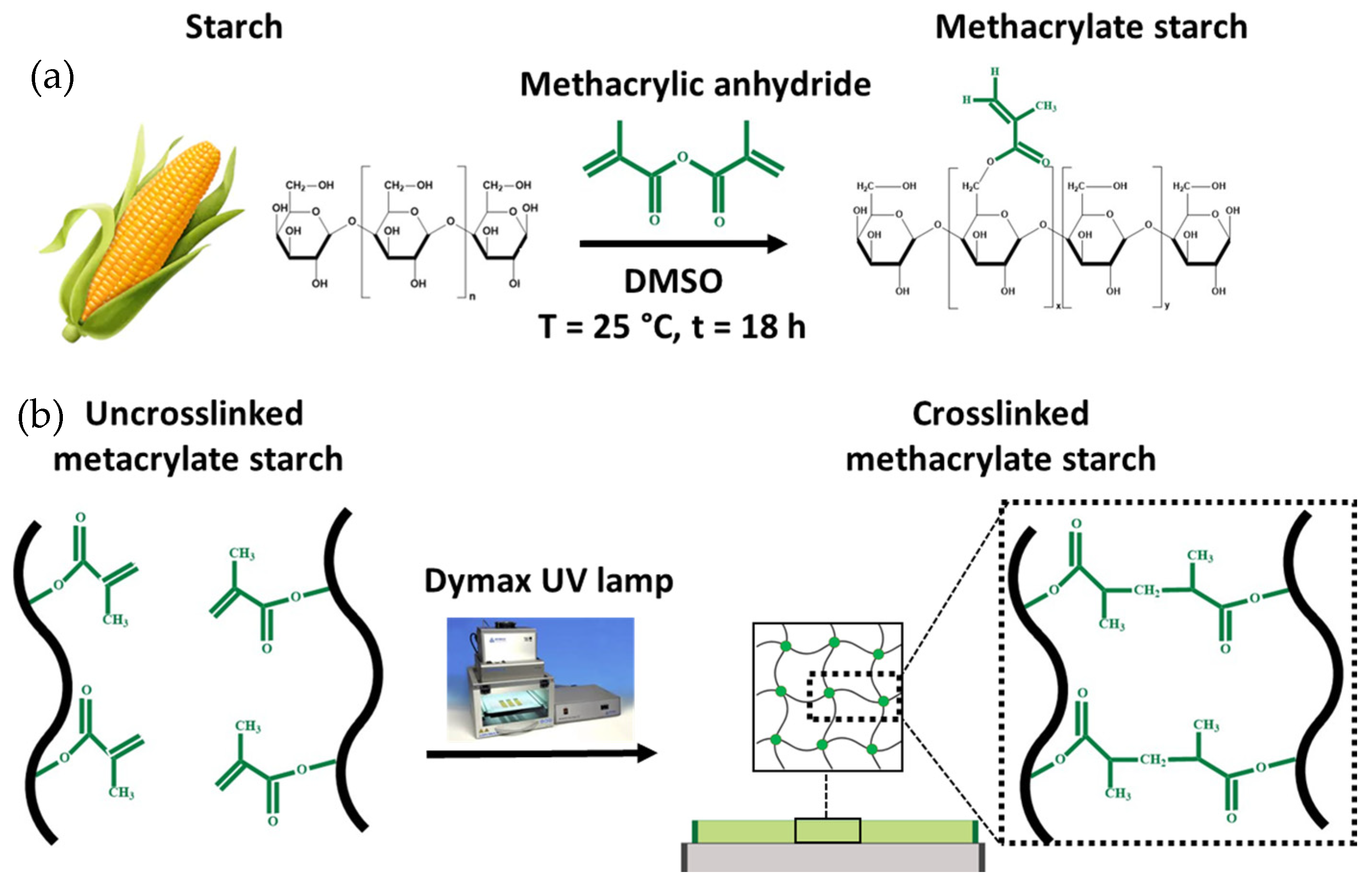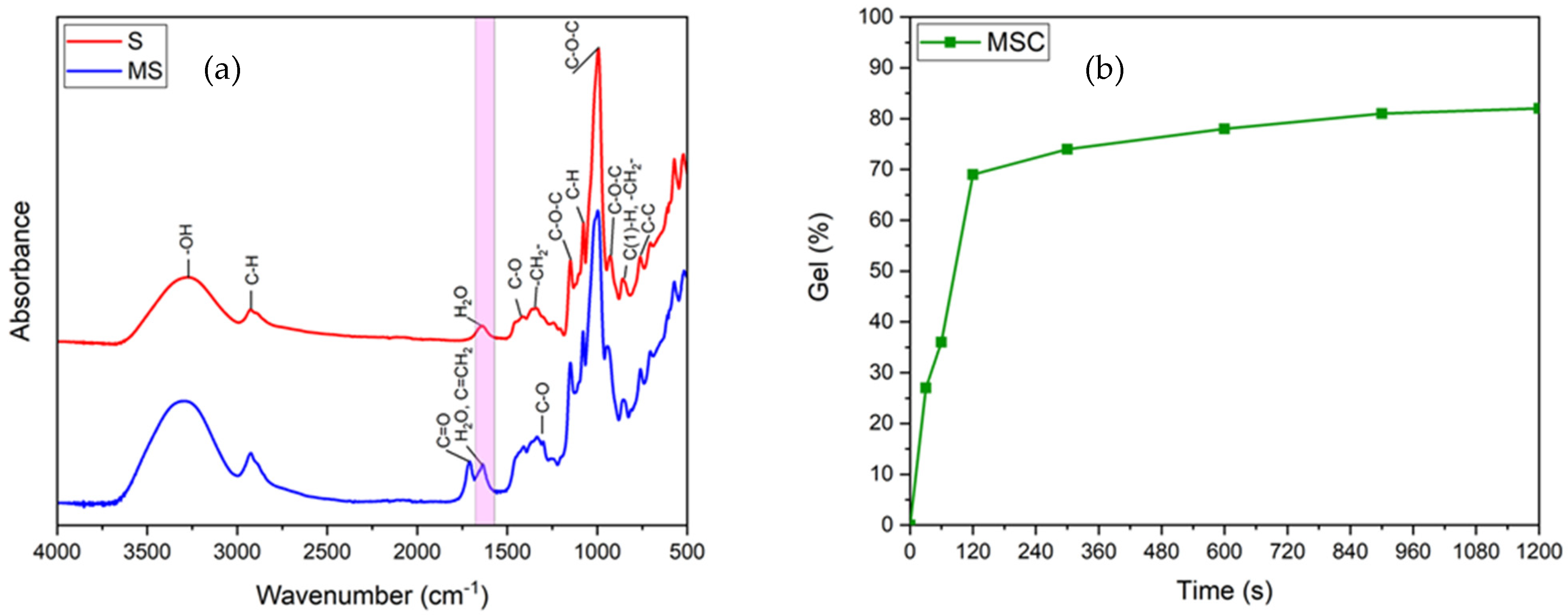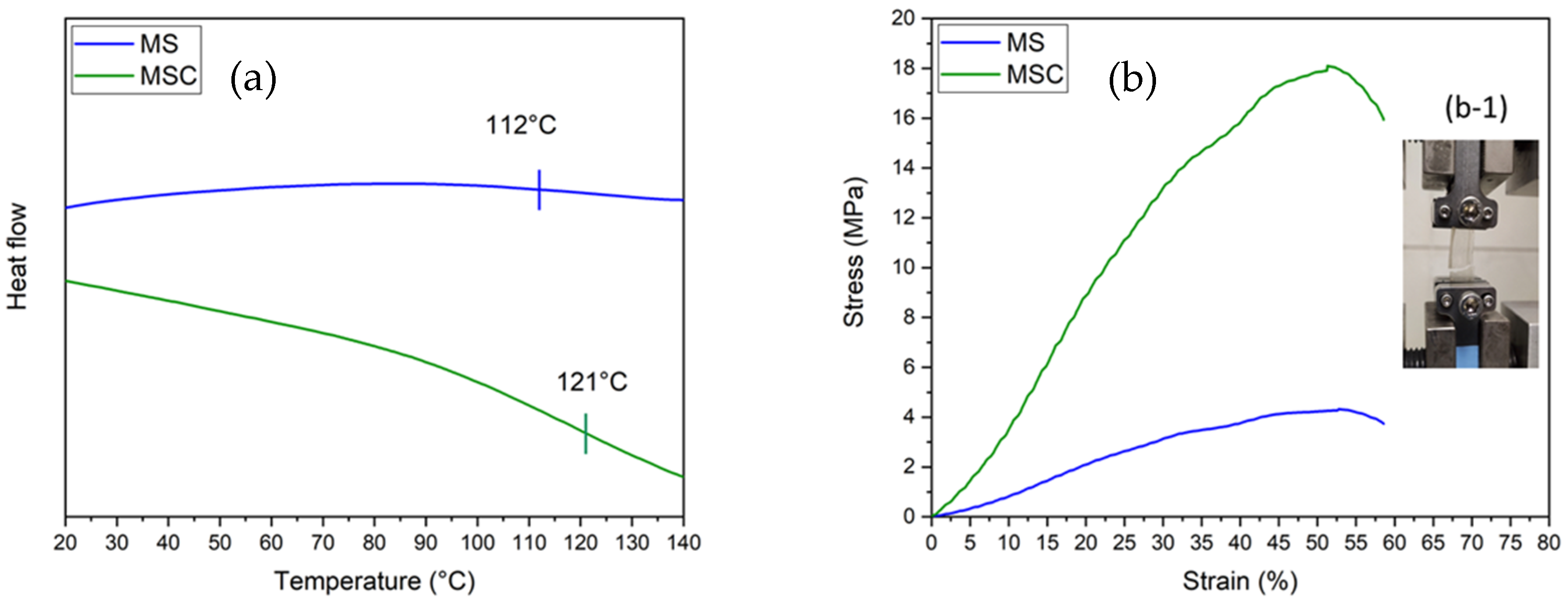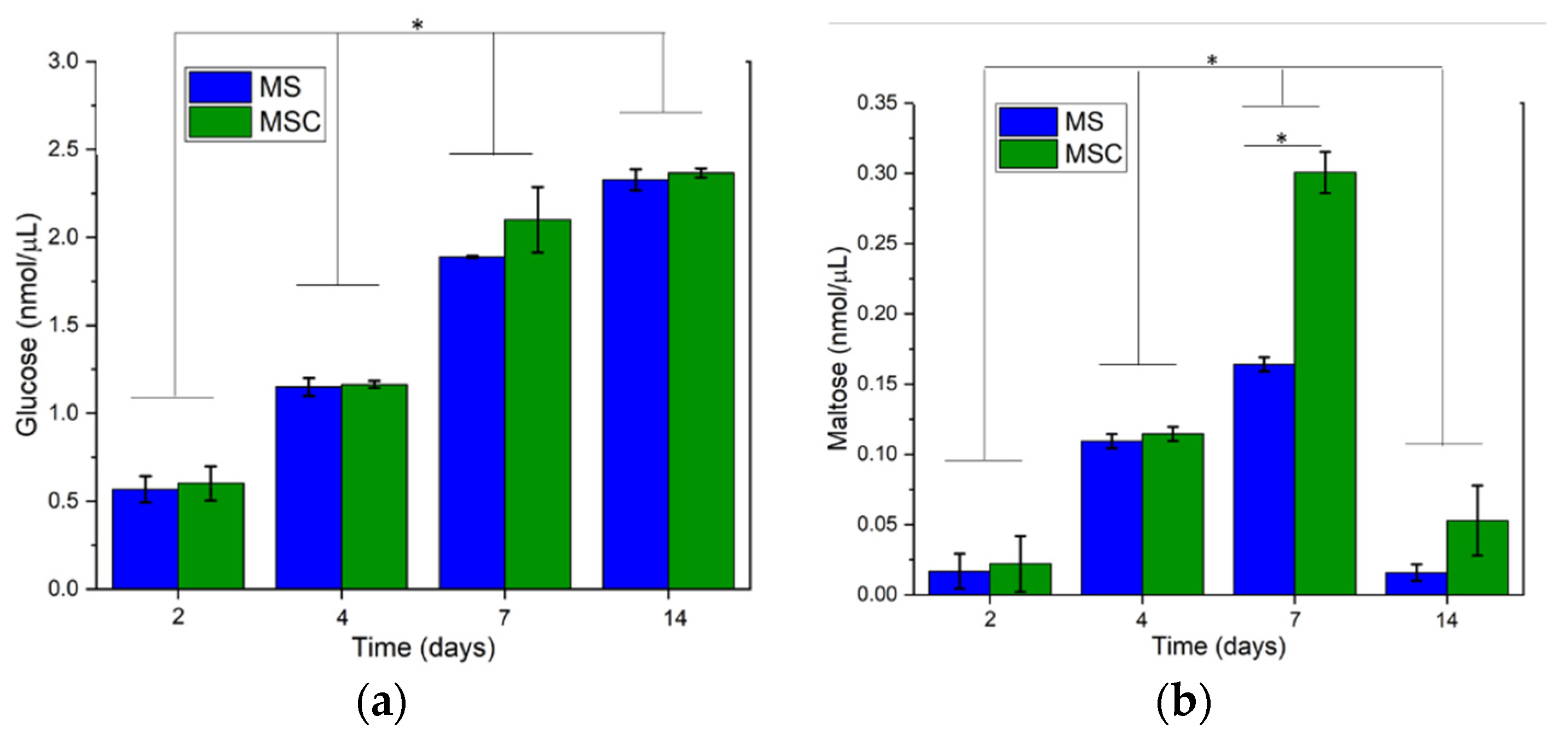UV-Cured Biodegradable Methacrylated Starch-Based Coatings
Abstract
1. Introduction
2. Materials and Methods
2.1. Materials
2.2. Synthesis of Methacrylated Starch
2.3. Casting and Photocuring of Methacrylated Starch Coating
2.4. Characterization
2.4.1. Attenuated Total Reflectance-Fourier Transform Infrared Spectroscopy (ATR-FTIR)
2.4.2. Gel Content
2.4.3. Differential Scanning Calorimetry (DSC)
2.4.4. Tensile Test
2.4.5. Pencil Hardness
2.4.6. Adhesion Measurement
2.4.7. Solvent Rub Resistance test
2.4.8. Contact Angle
2.4.9. Enzymatic Degradation
3. Results and Discussion
3.1. Confirmation of Starch Methacrylation and Photocuring Process
3.2. Thermal and Mechanical Properties
3.3. Surface Properties of the UV-Cured Coatings
3.4. Enzymatic Degradation
4. Conclusions
Author Contributions
Funding
Institutional Review Board Statement
Informed Consent Statement
Data Availability Statement
Conflicts of Interest
References
- Hassan, B.; Chatha, S.A.S.; Hussain, A.I.; Zia, K.M.; Akhtar, N. Recent advances on polysaccharides, lipids and protein based edible films and coatings: A review. Int. J. Biol. Macromol. 2018, 109, 1095–1107. [Google Scholar] [CrossRef]
- Dastpak, A.; Yliniemi, K.; De Oliveira Monteiro, M.C.; Höhn, S.; Virtanen, S.; Lundström, M.; Wilson, B.P. From waste to valuable resource: Lignin as a sustainable anti-corrosion coating. Coatings 2018, 8, 454. [Google Scholar] [CrossRef]
- Wang, S.; Ma, S.; Xu, C.; Liu, Y.; Dai, J.; Wang, Z.; Liu, X.; Chen, J.; Shen, X.; Wei, J.; et al. Vanillin-derived high-performance flame retardant epoxy resins: Facile synthesis and properties. Macromolecules 2017, 50, 1892–1901. [Google Scholar] [CrossRef]
- Hu, Y.; Tian, Y.; Cheng, J.; Zhang, J. Synthesis of eugenol-based polyols via thiol–ene click reaction and high-performance thermosetting polyurethane therefrom. ACS Sustain. Chem. Eng. 2020, 8, 4158–4166. [Google Scholar] [CrossRef]
- Xin, J.; Zhang, P.; Huang, K.; Zhang, J. Study of green epoxy resins derived from renewable cinnamic acid and dipentene: Synthesis, curing and properties. RSC Adv. 2014. [Google Scholar] [CrossRef]
- Pezzana, L.; Mousa, M.; Malmström, E.; Johansson, M.; Sangermano, M. Bio-based monomers for UV-curable coatings: Allylation of ferulic acid and investigation of photocured thiol-ene network. Prog. Org. Coat. 2021, 150. [Google Scholar] [CrossRef]
- Noè, C.; Hakkarainen, M.; Sangermano, M. Cationic UV-curing of epoxidized biobased resins. Polymers 2021, 13, 89. [Google Scholar] [CrossRef]
- Chow, W.S.; Tan, S.G.; Ahmad, Z.; Chia, K.H.; Lau, N.S.; Sudesh, K. Biodegradability of epoxidized soybean oil based thermosets in compost soil environment. J. Polym. Environ. 2014, 22, 140–147. [Google Scholar] [CrossRef]
- Auvergne, R.; Caillol, S.; David, G.; Boutevin, B.; Pascault, J.P. Biobased thermosetting epoxy: Present and future. Chem. Rev. 2014, 114, 1082–1115. [Google Scholar] [CrossRef]
- Sharmin, E.; Zafar, F.; Akram, D.; Alam, M.; Ahmad, S. Recent advances in vegetable oils based environment friendly coatings: A review. Ind. Crops Prod. 2015, 76, 215–229. [Google Scholar] [CrossRef]
- Tan, S.G.; Chow, W.S. Biobased epoxidized vegetable oils and its greener epoxy blends: A review. Polym. Plast. Technol. Eng. 2010, 49, 1581–1590. [Google Scholar] [CrossRef]
- Malburet, S.; Mauro, D.; Noè, C.; Mija, A. Sustainable access to fully biobased epoxidized vegetable oil thermoset materials prepared by thermal or UV-cationic processes. RSC Adv. 2020, 41954–41966. [Google Scholar] [CrossRef]
- Ma, S.; Li, T.; Liu, X.; Zhu, J. Research progress on bio-based thermosetting resins. Polym. Int. 2016, 65, 164–173. [Google Scholar] [CrossRef]
- Lacroix, M.; Le, T.C. Edible films and coatings from non- starch polysaccharides. Innov. Food Packag. Overiew 2005, 338–361. [Google Scholar] [CrossRef]
- Alves, V.; Costa, N.; Hilliou, L.; Larotonda, F.; Gonçalves, M.; Sereno, A.; Coelhoso, I. Design of biodegradable composite films for food packaging. Desalination 2006, 199, 331–333. [Google Scholar] [CrossRef]
- Biopolymers—New Materials for Sustainable Films and Coatings; Plackett, D., Ed.; John Wiley & Sons, Ltd.: Chichester, UK, 2011; Volume 272, ISBN 9781119994312. [Google Scholar]
- Ayoub, A.S.; Rizvi, S.S.H. An overview on the technology of cross-linking of starch for nonfood applications. J. Plast. Film Sheeting 2009, 25, 25–45. [Google Scholar] [CrossRef]
- Turco, R.; Ortega-Toro, R.; Tesser, R.; Mallardo, S.; Collazo-Bigliardi, S.; Boix, A.C.; Malinconico, M.; Rippa, M.; Di Serio, M.; Santagata, G. Poly (lactic acid)/thermoplastic starch films: Effect of cardoon seed epoxidized oil on their chemicophysical, mechanical, and barrier properties. Coatings 2019, 9, 574. [Google Scholar] [CrossRef]
- Martins, Y.A.A.; Ferreira, S.V.; Silva, N.M.; Sandre, M.F.B.; Filho, J.G.O.; Leão, P.V.T.; Leão, K.M.; Nicolau, E.S.; Plácido, G.R.; Egea, M.B.; et al. Edible films of whey and Cassava starch: Physical, thermal, and microstructural characterization. Coatings 2020, 10, 59. [Google Scholar] [CrossRef]
- Eddin, A.S.; Tahergorabi, R. Efficacy of sweet potato starch-based coating to improve quality and safety of hen eggs during storage. Coatings 2019, 9, 205. [Google Scholar] [CrossRef]
- Escamilla-García, M.; Reyes-Basurto, A.; García-Almendárez, B.E.; Hernández-Hernández, E.; Calderón-Domínguez, G.; Rossi-Márquez, G.; Regalado-González, C. Modified starch-chitosan edible films: Physicochemical and mechanical characterization. Coatings 2017, 7, 224. [Google Scholar] [CrossRef]
- Zhang, Y.; Rempel, C.; Liu, Q. Thermoplastic starch processing and characteristics—A review. Crit. Rev. Food Sci. Nutr. 2014, 54, 1353–1370. [Google Scholar] [CrossRef] [PubMed]
- Kim, M.; Lee, S.J. Characteristics of crosslinked potato starch and starch-filled linear low-density polyethylene films. Carbohydr. Polym. 2002. [Google Scholar] [CrossRef]
- Woo, K.; Seib, P.A. Cross-linking of wheat starch and hydroxypropylated wheat starch in alkaline slurry with sodium trimetaphosphate. Carbohydr. Polym. 1997, 33, 263–271. [Google Scholar] [CrossRef]
- Woo, K.S.; Seib, P.A. Cross-linked resistant starch: Preparation and properties. Cereal Chem. 2002, 79, 819–825. [Google Scholar] [CrossRef]
- Reddy, I.; Seib, P.A. Modified waxy wheat starch compared to modified waxy corn starch. J. Cereal Sci. 2000, 31, 25–39. [Google Scholar] [CrossRef]
- Hamdi, G.; Ponchel, G.; Duchêne, D. Formulation of epichlorohydrin cross-linked starch microspheres. J. Microencapsul. 2001, 18, 373–383. [Google Scholar] [CrossRef]
- Sangermano, M.; Razza, N.; Crivello, J.V. Cationic UV-curing: Technology and applications. Macromol. Mater. Eng. 2014, 299, 775–793. [Google Scholar] [CrossRef]
- Sangermano, M.; Roppolo, I.; Messori, M. UV-cured functional coatings. RSC Smart Mater. 2015, 2015, 121–133. [Google Scholar]
- Sangermano, M.; Roppolo, I.; Chiappone, A. New horizons in cationic photopolymerization. Polymers 2018, 10, 136. [Google Scholar] [CrossRef]
- Hedin, J.; Östlund, Å.; Nydén, M. UV induced cross-linking of starch modified with glycidyl methacrylate. Carbohydr. Polym. 2010, 79, 606–613. [Google Scholar] [CrossRef]
- Noè, C.; Tonda-Turo, C.; Chiappone, A.; Sangermano, M.; Hakkarainen, M. Light processable starch hydrogels. Polymers 2020, 12, 1359. [Google Scholar] [CrossRef] [PubMed]
- Zhai, M.; Yoshii, F.; Kume, T. Radiation modification of starch-based plastic sheets. Carbohydr. Polym. 2003, 52, 311–317. [Google Scholar] [CrossRef]
- Delville, J.; Joly, C.; Dole, P.; Bliard, C. Solid state photocrosslinked starch based films: A new family of homogeneous modified starches. Carbohydr. Polym. 2002, 49, 71–81. [Google Scholar] [CrossRef]
- Detduangchan, N.; Wittaya, T. Effect of UV-treatment on properties of biodegradable film from rice starch. World Acad. Sci. Eng. Technol. 2011, 81, 464–469. [Google Scholar]
- Zain, A.H.M.; Wahab, M.K.A.; Ismail, H. Solid-state photo-cross-linking of cassava starch: Improvement properties of thermoplastic starch. Polym. Bull. 2018, 75, 3341–3356. [Google Scholar] [CrossRef]
- Delville, J.; Joly, C.; Dole, P.; Bliard, C. Influence of photocrosslinking on the retrogradation of wheat starch based films. Carbohydr. Polym. 2003, 53, 373–381. [Google Scholar] [CrossRef]
- Zhou, J.; Zhang, J.; Ma, Y.; Tong, J. Surface photo-crosslinking of corn starch sheets. Carbohydr. Polym. 2008, 74, 405–410. [Google Scholar] [CrossRef]
- ASTM D3363–05 International Standard Test Method for Film Hardness by Pencil Test 1; ASTM: West Conshohocken, PA, USA, 2005.
- ASTM D3359-B Standard Test Methods for Measuring Adhesion by Tape Test 1; ASTM: West Conshohocken, PA, USA, 2012.
- ASTM D5402-06 Standard Practice for Assessing the Solvent Resistance of Organic Coatings Using Solvent Rubs; ASTM: West Conshohocken, PA, USA, 2006.
- Papadakis, V.G. Estimation of Estimation of surface free energy of polymres. J. Appl. Polym. Sci. 1969, 13, 1741–1747. [Google Scholar]
- Kizil, R.; Irudayaraj, J.; Seetharaman, K. Characterization of irradiated starches by using FT-Raman and FTIR spectroscopy. J. Agric. Food Chem. 2002. [Google Scholar] [CrossRef]
- Wu, D.; Hakkarainen, M. A closed-loop process from microwave-assisted hydrothermal degradation of starch to utilization of the obtained degradation products as starch plasticizers. ACS Sustain. Chem. Eng. 2014. [Google Scholar] [CrossRef]
- Reis, A.V.; Guilherme, M.R.; Moia, T.A.; Mattoso, L.H.C.; Muniz, E.C.; Tambourgi, E.B. Synthesis and characterization of a starch-modified hydrogel as potential carrier for drug delivery system. J. Polym. Sci. Part. A Polym. Chem. 2008. [Google Scholar] [CrossRef]
- Liu, X.; Lan, C.; Al, A.; Yu, L.; Zhou, S. Preparation of cross-linked high amylose corn-starch and its effects on self-reinforced starch films. Int. J. Food Eng. 2016, 12, 673–680. [Google Scholar] [CrossRef]
- Yeon, K.; Shim, J.; Gyu, H. Mechanical properties of gellan and gelatin composite films. Carbohydr. Polym. 2004, 56, 251–254. [Google Scholar] [CrossRef]
- Ma, S.; Kovash, C.S., Jr.; Webster, D.C. Effect of solvents on the curing and properties of fully bio-based thermosets for coatings Effect of solvents on the curing and properties of fully bio-based thermosets for coatings. J. Coat. Technol. Res. 2017. [Google Scholar] [CrossRef]
- Nelson, T.J.; Galhenage, T.P.; Webster, D.C. Catalyzed crosslinking of highly functional biobased epoxy resins catalyzed crosslinking of highly functional biobased epoxy resins. J. Coat. Technol. Res. 2013, 10, 589–600. [Google Scholar] [CrossRef]
- Gadhave, R.V.; Mahanwar, P.A.; Gadekar, P.T. Effect of glutaraldehyde on thermal and mechanical properties of starch and polyvinyl alcohol blends. Des. Monomers Polym. 2019, 22, 164–170. [Google Scholar] [CrossRef]
- Awaja, F.; Gilbert, M.; Kelly, G.; Fox, B.; Pigram, P.J. Adhesion of polymers. Prog. Polym. Sci. 2009, 34, 948–968. [Google Scholar] [CrossRef]
- Colivet, J.; Carvalho, R.A. Hydrophilicity and physicochemical properties of chemically modified cassava starch films. Ind. Crops Prod. 2017, 95, 599–607. [Google Scholar] [CrossRef]
- Dalvi, V.H.; Rossky, P.J. Molecular origins of fluorocarbon hydrophobicity. Proc. Natl. Acad. Sci. USA 2010, 107, 13603–13607. [Google Scholar] [CrossRef]
- Sagnelli, D.; Cavanagh, R.; Xu, J.; Swainson, S.M.E.; Blennow, A.; Duncan, J.; Taresco, V.; Howdle, S. Starch/poly (Glycerol-Adipate) nanocomposite film as novel biocompatible materials. Coatings 2019, 9, 482. [Google Scholar] [CrossRef]
- Nawaz, M.A.; Pervez, S.; Jamal, M.; Jan, T.; Khan, W.; Rauf, A.; Aman, A.; Qader, S.A.U. Maltose deterioration approach: Catalytic behavior optimization and stability profile of maltase from bacillus licheniformis KIBGE-IB4. Biotechnol. Rep. 2019, 24, e00400. [Google Scholar] [CrossRef] [PubMed]
- Rajagopalan, G.; Krishnan, C. α-Amylase production from catabolite derepressed bacillus subtilis KCC103 utilizing sugarcane bagasse hydrolysate. Bioresour. Technol. 2008, 99, 3044–3050. [Google Scholar] [CrossRef] [PubMed]





| Sample | Tg (°C) | Young’s Modulus (MPa) | Elongation at Break (%) | Ultimate Tensile Strength (MPa) |
|---|---|---|---|---|
| MS | 112 | 9.4 ± 0.9 | 49 ± 12 | 4.3 ± 1.2 |
| MSC | 121 | 39.3 ± 5.7 | 48 ± 15 | 18.1 ± 2.9 |
| Sample | Pencil Hardness | Adhesion (%) | MEK Resistance | Water Contact Angle (°) | Hexadecane Contact Angle (°) | γ (mN/m) |
|---|---|---|---|---|---|---|
| MSC | 7H | 99 | >200 | 85 ± 5 | 24.8 ± 4 | 29.8 |
Publisher’s Note: MDPI stays neutral with regard to jurisdictional claims in published maps and institutional affiliations. |
© 2021 by the authors. Licensee MDPI, Basel, Switzerland. This article is an open access article distributed under the terms and conditions of the Creative Commons Attribution (CC BY) license (http://creativecommons.org/licenses/by/4.0/).
Share and Cite
Noè, C.; Tonda-Turo, C.; Carmagnola, I.; Hakkarainen, M.; Sangermano, M. UV-Cured Biodegradable Methacrylated Starch-Based Coatings. Coatings 2021, 11, 127. https://doi.org/10.3390/coatings11020127
Noè C, Tonda-Turo C, Carmagnola I, Hakkarainen M, Sangermano M. UV-Cured Biodegradable Methacrylated Starch-Based Coatings. Coatings. 2021; 11(2):127. https://doi.org/10.3390/coatings11020127
Chicago/Turabian StyleNoè, Camilla, Chiara Tonda-Turo, Irene Carmagnola, Minna Hakkarainen, and Marco Sangermano. 2021. "UV-Cured Biodegradable Methacrylated Starch-Based Coatings" Coatings 11, no. 2: 127. https://doi.org/10.3390/coatings11020127
APA StyleNoè, C., Tonda-Turo, C., Carmagnola, I., Hakkarainen, M., & Sangermano, M. (2021). UV-Cured Biodegradable Methacrylated Starch-Based Coatings. Coatings, 11(2), 127. https://doi.org/10.3390/coatings11020127








